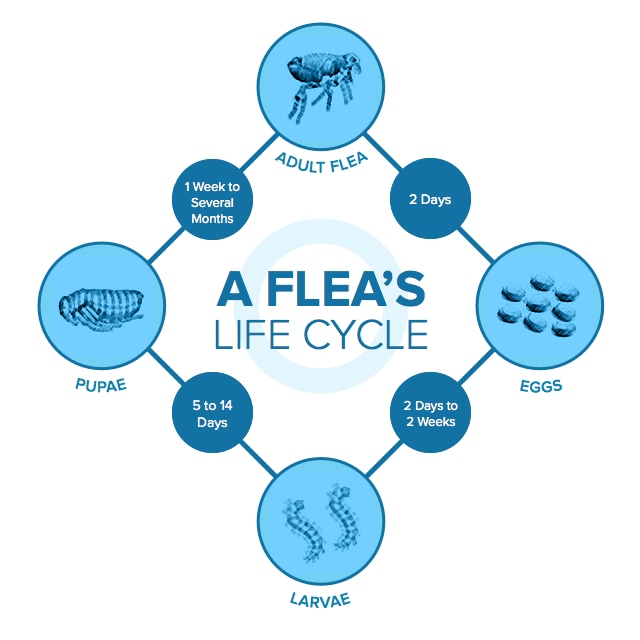








Work smarter, not harder.
 1
1




"Study books and observe nature; if they do not agree, throw away the books." ~ William A. Albrecht








Márk Mészáros wrote:That's what I meant, we most likely brought the fleas in that hopped off our cats, and I'm not sure if it's reasonable to get this amount of fleas in just by walking in and out of the house.

"Study books and observe nature; if they do not agree, throw away the books." ~ William A. Albrecht




 1
1





There are four stages in the life cycle of a flea: egg, larva, pupa, and adult. Depending on the environmental temperature and humidity levels, the total life cycle will take anywhere from a couple weeks to many months. Optimal conditions for fleas are between 70-85°F and 70 percent humidity.
Flea Eggs
The beginning of the life cycle occurs when an adult female flea lays eggs following a blood meal from the host (e.g., your pet). Blood is necessary for the adult flea to reproduce. These eggs are small, white objects (slightly smaller than a grain of sand) that are laid in the pet’s fur in bunches of about 20. A single adult female can lay about 40 eggs every day.
The eggs will fall off your pet as s/he moves, allowing them to be disbursed throughout the environment where your pet spends his or her time. Eggs represent about one-half (50 percent) of the entire flea population present in an average home.
Eggs take anywhere from two days to two weeks to develop, hatching when environmental conditions are just right for them. If temperatures are cold and dry, the eggs will take longer; if temperatures are warm and humidity levels are high, the eggs will hatch at a faster rate. Larvae then emerges as the next life stage.
Flea Larvae
The emerging larvae are blind and will avoid being out in the light. They develop over several weeks by eating pre-digested blood (known as flea “dirt”) that adult fleas pass, along with other organic debris in the environment.
In appearance, flea larvae can be up to ¼-inch long and are white (almost see-through) and legless. Larvae make up about 35 percent of the flea population in the average household. If conditions are favorable, the larvae will spin cocoons in about 5-20 days of hatching from their eggs. This leads to the next life stage, called the cocoon or pupae stage.
Flea Pupae
The pupae stage of the flea life cycle accounts for about 10 percent of the flea population in a home. This cocoon stage is the last developmental stage before the adult flea emerges. The cocoon protects the pupae for several days or weeks before the adult flea emerges. If environmental conditions are not right for emergence, the cocoon can protect the developing flea for months, and in some cases, years.
Cocoons have a sticky outer coating that allows them to hide deep in the carpeting and not be easily removed by light vacuuming or sweeping. The cocoon also serves to protect the developing adults from chemicals.
The adult flea will not emerge until the presence of a potential host is made obvious - by vibrations, rising levels of carbon dioxide, and body heat. This may be triggered by your pet walking by, or people moving in the house, alerting the flea to emerge from its cocoon to feed.
Adult Fleas
Once a flea has emerged from the cocoon, it will need to begin feeding from a host within a few hours. Shortly after the first meal, adult fleas will breed and begin laying eggs within a few days. Female fleas are not able to lay eggs until they obtain a blood meal.
New adult fleas have a flat-bodied appearance and are very small and dark in color. Once they have had a chance to feed off your pet, they will become larger and lighter in color, taking on the more recognizable flea shape. Adult fleas account for less than 5 percent of the entire flea population in a home. They spend the majority of their time living on the host while they feed, breed, and lay eggs, and can live anywhere from a couple of weeks to several months on the host animal.
Eliminating Fleas
Use your knowledge of the flea life cycle to eliminate an infestation. Treat the environment properly by vacuuming regularly for several weeks and thoroughly washing bedding and toys in hot soapy water to remove eggs, larvae, and pupae. Remember to seal and remove vacuum bags after a cleaning session. You can even encourage faster emergence of the remaining pupae with a humidifier and an increase in the home temperature.
"Study books and observe nature; if they do not agree, throw away the books." ~ William A. Albrecht
 1
1




 1
1




we don't have a problem with lack of water we have a problem with mismanagement
beavers the original permies farmers
If there is no one around to smell you ,do you really stink!

|
I didn't like the taste of tongue and it didn't like the taste of me. I will now try this tiny ad:
The new permaculture playing cards kickstarter is now live!
https://www.kickstarter.com/projects/paulwheaton/garden-cards
|


